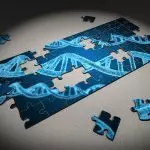[Originally published as A Big Bang—Part 3]
In our previous article, we investigated the standard model (the big bang) on scientific grounds. We found that the big bang is not scientific in the sense that none of its major steps have been verified by the scientific method. However, there are things that are reasonable and true that cannot be verified by science.
So we must ask, is the big bang reasonable? Are there good reasons to believe it despite its lack of scientific verification?
Science vs. History
When exposed to the fact that the big bang has not been verified by the scientific method, critics sometimes respond, “Well, neither has Genesis! God speaking things into existence cannot be repeated in a laboratory.” This is true of course.[1]
Biblical creation is not science; it is recorded history. We believe in the facts of Genesis for the same reason we believe George Washington crossed the Delaware River in 1776. These events were recorded by eye-witnesses. Their written testimony is evidence that the events actually transpired. While we cannot demonstrate Washington’s crossing of the Delaware in a laboratory, we nonetheless have a good, rational reason to believe it.
Of course, Genesis is not just any history book. It is God-breathed (2 Timothy 3:16).
God used men to write exactly what He wanted (2 Peter 1:20-21). This fact should increase, not decrease, our confidence in the books of the Bible. After all, it is sensible to believe recorded history. How much more confidence should we have in recorded history that is endorsed by the Lord!
But is the big bang recorded history? Was the secular story of origins recorded by eyewitnesses? Does it have the endorsement of God?
Clearly, the answer to all of these questions is: no. No one witnessed the big bang or any of its steps. No one has seen a universe come into existence, or expand from a singularity. No one has seen energy become matter without antimatter. No one has seen stars or planets form. And no one has observed or recorded the alleged future heat death of the universe. And not only does the big bang lack endorsement from God, but God’s description of origins is contrary to the big bang.
The bottom line is this: creationists have a rational basis for trusting in Genesis—it is recorded history; whereas secularists do not have any historical or scientific basis for believing in the big bang.
Consistent with Science?
But isn’t the big bang at least consistent with modern science? Granted, we cannot prove any of the steps of the big bang by scientific means, and we have no historical support for it. But don’t we at least have a self-consistent story that is compatible with the findings of modern science?
Unfortunately, the scientific consistency of the standard model has been overstated. Indeed, even honest secular scientists will concede that the big bang has problems. Many of these appear in secular textbooks on cosmology. Secularists claim to have solved some of them, but others remain. Let’s consider a few of these.
Where’s the Antimatter?
One very serious problem with the big bang story is called the baryon asymmetry problem. Baryons are particles like the protons and neutrons that comprise the nucleus of an atom. Atoms are the constituent particles of all the matter in the universe. And according to the big bang, all matter was originally produced from the energy of the big bang as it cooled with expansion.
We know that energy can be used to create matter—we can verify this in a laboratory. But for every particle of matter that we make from energy, we get a particle of antimatter. Antimatter has the same properties of matter, except the charges of the particles are reversed. So if energy produces a proton, it will also produce an anti-proton.
There are no known exceptions.
Therefore, according to laboratory physics, if all the particles of matter in the universe were produced from energy from the big bang, then there should be an equal amount of antimatter in the universe. After all, for every particle of matter produced from energy, there must be a particle of antimatter. Yet, the universe is essentially matter only.
Putting it another way, if the big bang were true the universe should be 50% matter, and 50% antimatter. But in fact, the universe is essentially 100% matter.[2] Therefore, we must conclude that the big bang is not true.
Note that this conclusion is based on the observable, testable, repeatable results of laboratory physics.
Some physicists have proposed a potential solution to the baryon asymmetry problem. They suppose that every once in a while, energy can become matter without producing any anti-matter.
Note that this conjecture is not based on testable science.
On the contrary, science shows us that matter and antimatter are produced in exactly equal quantities. Rather this conjecture was proposed to rescue the big bang from apparent evidence to the contrary. One of the most accepted versions of this hypothesis predicted that a proton would eventually spontaneously decay into a pion and positron. However, experiments have refuted this hypothesis.[3] Still, many secular scientists hope that some solution will be discovered in the future.
Missing Population III Stars
Recall from the previous article that the big bang was supposed to have produced only the light elements hydrogen and helium, and trace amounts of lithium. All the heavier elements were supposedly produced later in the cores of massive stars. If this were so, then the first generation of stars would be comprised solely of hydrogen, helium, and trace amounts of lithium. There could be no heavier elements like oxygen or carbon because these would not have formed yet.
These first generation of stars which lack elements heavier than lithium are called “population III.”
Many population III stars expend energy sufficiently slowly that they should still be around even if they formed shortly after the big bang. Yet, not one population III star has been observed.
This is remarkable considering there are over 100 billion stars in our galaxy alone, and at least that many galaxies. We find they are all population II (some heavy elements) or population I (even more heavy elements). Observational science is consistent with the position that the universe was created with some heavy elements already in it, and this is contrary to the predictions of the big bang, but is consistent with biblical creation.[4]
The Singularity Problem
The big bang supposedly started as a singularity—a point of no size that contained all the energy of the universe and even space itself. What do the laws of physics predict about such a singularity? The answer is that they cannot make any predictions because we have not yet discovered the laws of physics that apply in such a situation. Let me explain.
We have a branch of physics that describes what happens on extremely small scales. This is called quantum mechanics. And we also have a branch of physics that describes what happens in extremely intense gravitational fields. This is called general relativity. But general relativity and quantum mechanics are not entirely compatible with each other.
And no one has been able to discover the branch of physics that describes what happens in extremely intense gravitational fields that are also very small. But this is exactly the situation in which the big bang allegedly started. Big bang supporters must accept on blind faith that such a situation is even possible. Currently, the initial state of the big bang cannot be analyzed by scientific means. It is purely a matter of faith.
Furthermore, no one has been able to explain how the singularity itself came into existence, nor why it began expanding. Ironically, the one thing the big bang does not explain is the origin of the universe. It is simply a story about what supposedly happened afterward.
The Horizon Problem
Critics of the Bible sometimes claim that the universe cannot be only 6000 years old because there is no way to get the light from galaxies that are billions of light years away. They claim that this light travel time problem disproves biblical creation (as if this were a problem for Almighty God). Of course, there are several ways to get the light here within the biblical time frame even without appealing to the supernatural.
But ironically, the big bang has a light travel time problem of its own. It is called the horizon problem.
According to the standard model, shortly after the singularity began to expand, the universe developed temperature differences: hot spots and cold spots. Today, the farthest regions of the universe have essentially the same temperature as indicated by the cosmic microwave background. So the hot spots must have transmitted some of their energy to the cold spots, thereby cooling the hot spots and warming the cool spots.
The problem is this: even if we grant 13.8 billion years, there has not been enough time for light/energy to travel from the hot spots to the cold spots even once, to say nothing of the multiple times it would take to even out the temperature differences. After all, these hot spots and cold spots might be on opposite sides of the visible universe. And since their light is just now reaching us, obviously it would take much longer to travel twice that distance.
Ironically, making the universe older will not solve the problem. This is because no matter how old the visible universe is, light from one side will reach us long before it reaches the other side. So we should always see enormous temperature differences if the big bang were true.
But we don’t.
Monopoles
Just as electrons have a negative electric charge and protons have a positive electric charge, magnets have a north magnetic pole and a south magnetic pole. Theoretically, there could be particles that have a single magnetic pole (north or south, but not both), just as some particles have a single electric charge (positive or negative, but not both). These particles would be called magnetic monopoles.
Such particles are predicted to be produced at the extremely high temperatures associated with the big bang. Yet, no magnetic monopoles have ever been discovered. This suggest that the universe never was so hot, which means the universe did not begin in a big bang.
To be Continued
Footnotes
[1] And it is a tu quoque fallacy. The fact that biblical creation cannot be repeated in a laboratory does not undo the fact that none of the steps of the big bang can be demonstrated scientifically. Neither creation nor the big bang can be demonstrated by the scientific method. However, biblical creation justifies our confidence in the scientific method, whereas the big bang would undermine it.
[2] There are only trace amounts of antimatter in the universe; these are produced by high-energy processes, and are then generally immediately destroyed by contact with matter.
[3] In particular, those theories that predicted proton decay with a half-life of less than 1035 years have been refuted. Some physicists still hope that a decay is possible but with a half-life much larger than predicted.
[4] According to Genesis, Earth was made before any of the celestial objects. Earth had water at the beginning, which contains the element oxygen. Therefore, elements heavier than lithium existed before stars.







